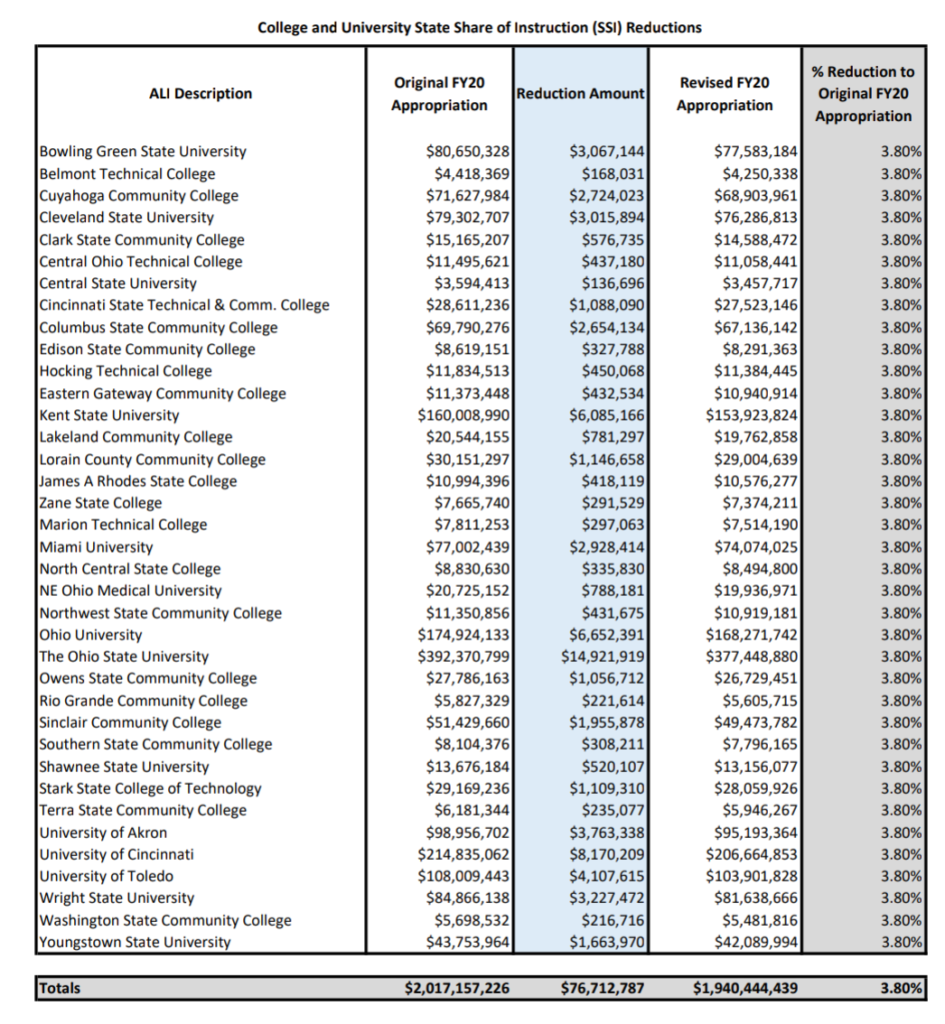American Association of University Professors
News & Blog
05.07.20
DeWine announces higher ed cuts. Here is what you can do.
| Gov. Mike DeWine announced a total of $775 million in spending cuts for the rest of the fiscal year ending on June 30, 2020 at his press briefing yesterday, May 5. The cuts will be implemented over the next two months to balance the state budget. The governor chose not to tap the state’s “Rainy Day Fund” at this time, saying that it likely will be needed in the next fiscal year and possibly the year after that. With soaring unemployment and declining tax receipts, DeWine had notified state agencies near the end of March that he would be seeking budget reductions for the 4th quarter of the fiscal year. Departments were required to submit their reduction plans by April 7. We had written to Chancellor Gardner on March 30 urging that State Share of Instruction (SSI) remain as intact as possible, and also asking him to encourage institutions to refocus their spending on the academic mission. Nevertheless, among the $775 million in cuts is a $110 million loss to the Ohio Department of Higher Education (ODHE). Given that SSI — the main funding source from the state to public colleges and universities — makes up more than 70% of the ODHE budget, it was no surprise it bore the brunt of the cuts. A total of $76,712,787 in SSI cuts are being made in the less than two months remaining of this fiscal year. In terms of percentages: -The overall cut of $110 million to ODHE represents a 4% cut to original FY 20 appropriations, or a 16% cut for the 4th quarter. -The cut to SSI represents a 3.8% cut from the original FY 20 appropriations, or a 15.2% cut for the 4th quarter. Below is the chart that the state budget director released detailing the specific cuts to each public college and university. |

| This is obviously bad news for our institutions that already are under tremendous financial pressures. Many, if not most, institutions are projecting deficits in the tens of millions over the next year. However, we still do not know what cuts for FY 2021 might look like or when those will be announced. While the federal stimulus money should mitigate some of the immediate state funding loss, institutions are still facing uncertainty about summer and fall enrollments and whether campuses will be open this fall, in addition to issuing refunds in the millions to students for housing, food, and other fees for spring semester. Several universities already have announced massive layoffs and restructuring plans, and it is only a matter of time before other institutions put out their reduction plans. We recognize that our institutions are being faced with these serious and immediate fiscal challenges, and we encourage our chapters to engage and negotiate with their administrations to navigate these challenges as effectively as possible — to try to insure that instruction and our academic missions remain the first priority and not just a public talking point. Chapters should, however, view with skepticism any demands from administrations for longer-term “solutions” — “master planning.” This situation is too fluid for anyone to do more than guess at where things will be in three to six months, never mind beyond that. Things may very well get worse, but what “worse” will be remains a very open question. In short, we think that remaining at the table and engaged is the best strategy, even if it becomes somewhat grueling. We also need the federal government to step in with another relief bill that gives more direct aid to colleges and universities; otherwise, many of our institutions will be significantly limited moving forward. The changes that will be made in the immediate future will have long-term consequences. The One Ohio Now coalition, to which OCAAUP has belonged for many years, is spearheading a letter campaign to Ohio’s federal lawmakers asking for another investment in Ohio’s educational institutions and other vital public services. We strongly urge you to send messages to your U.S. Representative and U.S. Senators through this link to advocate for more funding for institutions of higher education. We also encourage you, if you have not done so already, to sign our statement that calls for solidarity among faculty at this time, and also calls upon institutions to refocus resources on the instructional and research missions. We plan to share this widely with administrators and state and federal lawmakers. As the statement indicates, we cannot accept further cuts to academics while administrative bloat and athletics largely remain unscathed. We can’t end up as institutions with ranks of vice presidents, fully-staffed athletic departments, and little to no faculty. After all, it is academics and the faculty that actually generate the revenue for our institutions. Moreover, while there is not much that state legislators can do about appropriations to higher ed in the immediate future, we can help keep our issues in front of them by sending a letter supporting HB 603, which would require the chancellor to conduct a study on how to assist colleges, universities, and students during the pandemic. We know that this is an extremely difficult time, and we appreciate those of you that participated in our day of action and solidarity on May 1 to help boost morale and highlight the importance of higher education before, during, and after this pandemic crisis. We will continue to do everything in our power to advocate for the value of higher education, higher education funding, and the importance of the role of the faculty. |